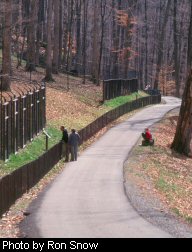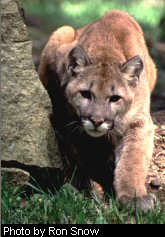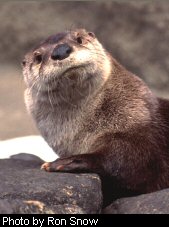

|
West Virginia State Wildlife Center: A Century of Conservation and Education By Rob Silvester
Wildlife conservation programs were originally designed to control the harvest of wildlife species, propagate animals, and to conserve and protect the natural resources of the state. In 1923, the Game and Fish Commission purchased property and created the French Creek Game Farm. As its name implies, several species such as quail, pheasant, turkey and deer were raised on the area. These species were used in an attempt to reintroduce wildlife throughout the state. As our understanding of wildlife biology and habitat requirements increased, it became evident that farm-raised animals failed to develop the necessary skills for survival in the wild and these programs were discontinued. From the beginning, the recreational and educational values of the Game Farm were recognized by area residents. In 1926 alone, nearly 6,000 visitors came to the Game Farm to view the animals. One large crowd gathered to see three elk brought by wagon from the railroad station. By 1927, the number of registered visitors grew to 20,000. Buffalo from Oklahoma were added to the exhibit in 1954 and attracted additional visitors. A proclamation by the President of the United States and the Governor of West Virginia created a National Hunting and Fishing Day in 1971. This event was initially celebrated at th A mobile wildlife exhibit stationed at the Game Farm traversed the state from 1974 to 1990, allowing nearly 250,000 residents to catch a glimpse of its unique tenants. Ironically, the original purpose of raising wildlife at the Game Farm had been overshadowed by its popularity as a tourist attraction. Half a century after its creation, the DNR Wildlife Resources Section decided to replace the antiquated wildlife facilities and exhibits. In 1984, monies from the Land and Water Conservation Fund of the U. S. Department of Interior were used to begin construction on new exhibits. A new facility was dedicated in September 1986 and renamed the West Virginia State Wildlife Center. Today, the 338-acre Wildlife Center is a modern zoological facility dedicated to presenting visitors a realistic and factual understanding of our state's wildlife resources. Located 12 miles south of Buckhannon on State Route 20, the Center displays over 28 different wildlife species. Native species such as mountain lion, elk, bison and gray wolves, eliminated from the state by the early 1900s, can now be seen roaming alongside more common species such as deer, turkey, red and gray foxes, bobcats and woodchucks. Introduced species, like the ring-necked pheasant and the European wild boar, can also be found at the Wildlife Center. A “state-of-the-art” river otter exhibit allows these playful aquatic mammals to be viewed above and below water, revealing their amazing swimming abilities. Along with river otters, West Virginia's state mammal, the black bear, is a featured attraction. With an average of 50,000 visitors per year, the Wildlife Center remains a very popular attraction. Guests from numerous states and foreign countries have joined visitors from all of West Virginia's 55 counties. The Wildlife Center is a popular destination for elementary school students from around the state. They learn about the history of wildlife conservation, biology, life histories, historical ranges, and threatened and endangered species. For many visitors, seeing a certain wildlife species for the very first time is an unforgettable experience. Visitors also learn that wildlife is a renewable resource and how hunting has contributed to successful conservation programs for many wildlife species throughout our state. And of course, our most famous resident — French Creek Freddie — captivates visitors as he makes his annual prediction of the onset of spring on Groundhog Day.
The Wildlife Center is vital part of the state's outdoor education programs. Its setting provides a unique opportunity to introduce visitors to critical issues such as urban wildlife and nuisance wildlife management, wildlife diseases, and new and innovative harvest strategies. The Wildlife Center is as dynamic as many of its exhibits. Only the first of a three-phase master plan has been developed. Future plans include new interpretive signs for the exhibit area, an educational and interpretive center, an auditorium, nocturnal animal, reptile, aquatic mammal and avian exhibits and an aquarium. As environmental issues play an increasingly important role in our lives, the Wildlife Center will continue its tradition of offering visitors an unparalleled understanding of our state's wildlife resources. Robert Silvester is the wildlife biologist at the West Virginia State Wildlife Center. |
 By the early 1900s, West Virginia's wildlife resources were severely depleted by unregulated harvesting and habitat loss. Species that were abundant only a few decades earlier were nearly exterminated from the state by 1911. These concerns led to the creation in 1921 of the Game and Fish Commission (forerunner of the Division of Natural Resources).
By the early 1900s, West Virginia's wildlife resources were severely depleted by unregulated harvesting and habitat loss. Species that were abundant only a few decades earlier were nearly exterminated from the state by 1911. These concerns led to the creation in 1921 of the Game and Fish Commission (forerunner of the Division of Natural Resources).  e Game Farm in 1978 and continued each year until it was moved to the Stonewall Jackson Lake State Park in 1996.
e Game Farm in 1978 and continued each year until it was moved to the Stonewall Jackson Lake State Park in 1996.  The Wildlife Center is the perfect setting for a family outing. In addition to the natural exhibits, family members can bring a lunch and enjoy the wooded picnic area complete with grills, tables, restroom facilities and a shelter. A gift shop is available to satisfy your souvenir and refreshment needs. You can go on a scavenger hunt near a pond, which is well stocked with trout, bass, catfish and bluegill. You can take a relaxing walk on an interpretive trail that meanders through a mature forest. Be sure to look for wildflowers, mushrooms or other natural treasures. If you listen closely, you may hear the distinctive drink-your-tea call of the rufous -sided towhee or the teacher, teacher, teacher call of the ovenbird. You may also hear the who cooks for you, who cooks for you all call of the elusive barred owl, the high-pitched bugle of a bull elk, or the eerie howl of coyotes or gray wolves.
The Wildlife Center is the perfect setting for a family outing. In addition to the natural exhibits, family members can bring a lunch and enjoy the wooded picnic area complete with grills, tables, restroom facilities and a shelter. A gift shop is available to satisfy your souvenir and refreshment needs. You can go on a scavenger hunt near a pond, which is well stocked with trout, bass, catfish and bluegill. You can take a relaxing walk on an interpretive trail that meanders through a mature forest. Be sure to look for wildflowers, mushrooms or other natural treasures. If you listen closely, you may hear the distinctive drink-your-tea call of the rufous -sided towhee or the teacher, teacher, teacher call of the ovenbird. You may also hear the who cooks for you, who cooks for you all call of the elusive barred owl, the high-pitched bugle of a bull elk, or the eerie howl of coyotes or gray wolves.